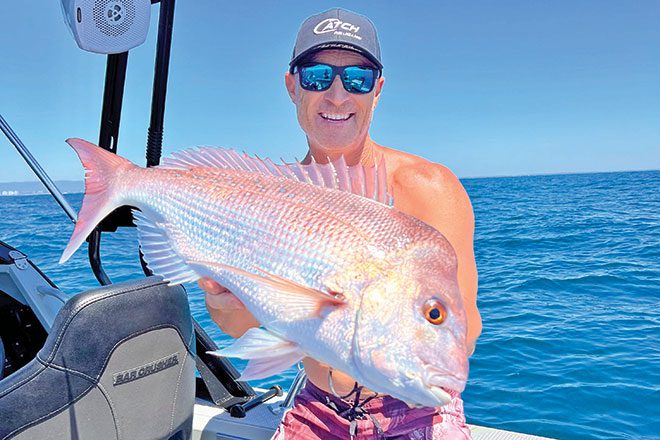To kick off, I’d like to wish a happy new year to everyone.
The past couple of years of writing and sharing what I know about fishing, boating and going to new places has been very enjoyable – I hope you’ve been able to get something out of it.
It looks as though 2023 will be an awesome year, with all the new tackle on the market, and here’s hoping the big red-suited person brought you something nice.
With any luck, many of you are enjoying a summer holiday and thinking about your plans for your next fishing adventure.
The warm months are generally great for chasing all the well-known summer species, such as marlin, mackerel and mangrove jack, but did you know that snapper can also be targeted at this time with outstanding results?
Actually, some of my biggest snapper catches have been landed between November through to January.
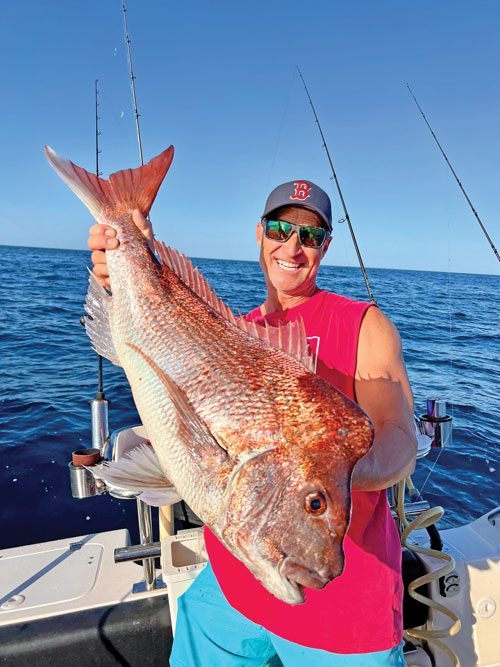
In this article I hope to pass on a few pointers to help you land that fish of your dreams.
Let’s talk about tackle preparation first, starting with the hooks and working our way up.
My preference when float-lining for summer snapper is Gamakatsu SL 12S 6/0 hooks because they are sticky sharp and that’s very important.
I gang them two-up with a swivel of about size 3-4 in the eye of the top hook to allow the bait to spin a bit and not cause the line to twist.
On to that, I’ll run a luminescent egg sinker of a size appropriate to the depth of water, the current and wind condition I need to fish.
That’s tied directly to monofilament line of anything between 15-30lb, so the sinker can run freely up the line.
The reel you choose should be able to hold about 300m of the line class you wish to fish.
As an example, if I’m fishing 15lb, I’ll go with a Shimano Tekota 500HGA, but if I go up to 30lb, I’ll use something along the lines of a Daiwa Saltist LW-40HA.
Both reels are overhead level-wind star drags and handle mono line very well.
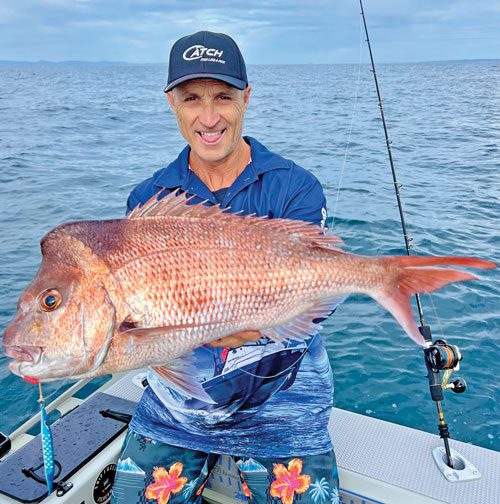
An overhead reel is far more appropriate to use in a float-lining situation because you can leave the reel in free spool and simply thumb the line to control the speed of the decent.
In addition, you will be able to feel the line under your thumb as a fish takes it and the spool speeds up as it takes the bait.
The principal is that you can thumb the spool to put resistance on the line to set the hook in the fish, that way if the fish decides to drop the bait, you can instantly take your thumb pressure off to allow it to come back for a second bite at the cherry.
Once you feel the fish is hooked, you pop it into gear and wind up the stretch in the mono and fight the fish in.
As I’ve said in previous articles, a good 7’-7’6” rod in the correct line class is important.
Don’t worry too much about line class because you can easily fish 15lb line in 65-85m of water and land some big fish.
The fish in the photos accompanying this article were all caught on 15lb gear, but I’ll go up to 30lb gear if kingfish are around, or if the fish are close to the bottom and there’s a chance the line will be touching the reef.
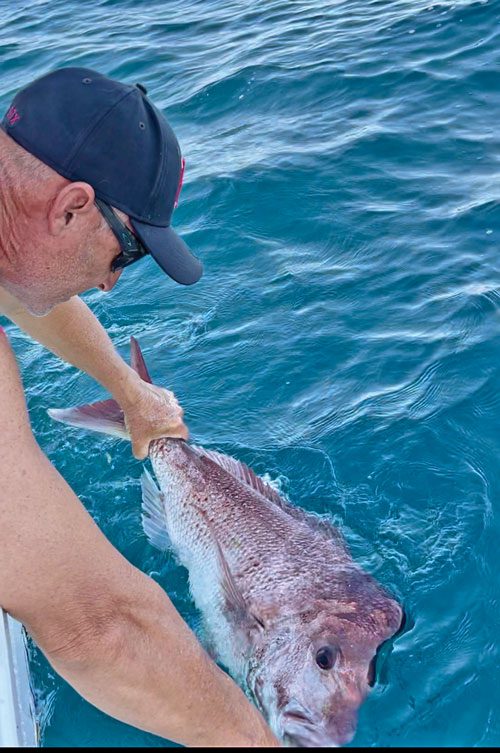
Next is putting yourself on the fish.
Generally, it’s a good idea to be on location pre-dawn or late afternoon as these are prime feeding times for fish.
Alternatively, try following the bite times, as I do.
You can use a bite time app on your phone, or you can follow the moon phases to calculate when the fish will come on the bite.
The question to ask is not where the fish were biting, but when.
Finding the fish by sounding the area is probably the next priority.
Go slow so your sounder can get its ping rate up and that way, any fish under the boat can be seen clearly, as shown in the screenshot of my sounder.
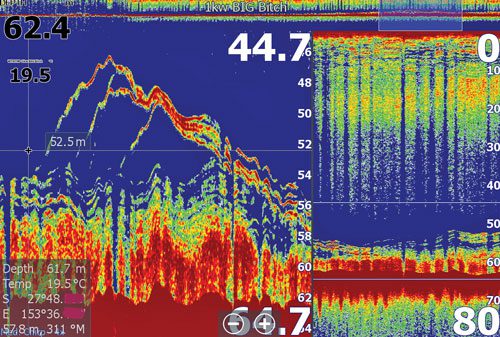
Admittedly, I am using a 1kW transducer, but in water up to 50 fathoms, most good sounders will draw good fish up if you pull the boat back to idle speed and take it slow.
Seeing the fish and being there at the right time are both crucial to successful fishing, not only for quality fish but for quantity also.
Watch your plotter to work out the drift and try to position your boat so that your bait passes through the sweet spot where the big ones are hanging.
Remember, it’s not a race to the bottom – you want your bait to suspend in the zone where the fish are feeding for as long as possible.
In the screenshot of the sounder, they are in fact 10-12m up from the bottom, so if your bait is on the sea floor, it’s not going to get the bite.
You can also see that I’ve zoomed the split screen in on the bottom so I can better interpret the soundings.
These are key points to good fishing.
Another tip is to present your bait neatly.
Check to see that the point of the hook is exposed, and the bait is the correct way around.
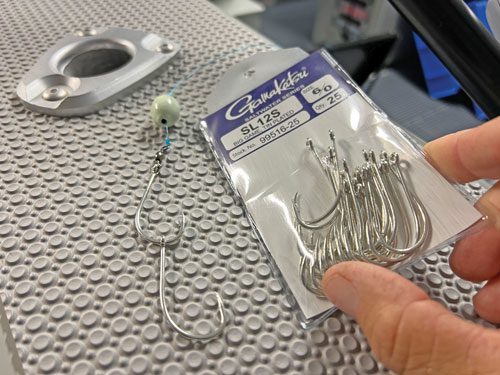
Usually, how the fish would swim naturally is how you want to present your bait and, once you’re ready to drop, lay it in the water to see if it swims straight or if it spins.
If it doesn’t look right, fix it.
If you do get a beauty, take a few pics and then decide to release it, that’s great.
Breeding stocks are crucial for overall sustainability and, while there are some ideas going around that snapper could die from barotrauma, there’s also a good chance that the fish will survive – particularly if you have handled it gently, released the air from its swim bladder and have it back into the water quickly, with the fish swimming upright as it descends.
I hope to have more information and research data on released snapper over the coming months – it will be interesting to find out what actually happens.
All of these tips will help you have a successful fishing mission for reds this summer and knowing they’re a year-round species on the Gold Coast makes the season even more attractive.
Finally, having the best gear you can afford is a good idea too – not only because it increases your chances of landing a beast but because it feels so good to buy new fishing gear!
Spoken like a true fisho.
Anyway, have the best new year ever and, if you’re keen to see how I go about fishing for snapper, check out some of the content on my YouTube channel, ‘Ship Faced Fishermen’.
Until next month, happy fishing.
 Bush ‘n Beach Fishing Magazine Location reports & tips for fishing, boating, camping, kayaking, 4WDing in Queensland and Northern NSW
Bush ‘n Beach Fishing Magazine Location reports & tips for fishing, boating, camping, kayaking, 4WDing in Queensland and Northern NSW

